-
Posts
22,596 -
Joined
-
Last visited
-
Days Won
119
nicknorman last won the day on June 5 2023
nicknorman had the most liked content!
Profile Information
-
Gender
Male
-
Location
Scotland
-
Interests
Electronics, gliding, motorbikes
-
Occupation
retired
-
Boat Name
Telemachus
Recent Profile Visitors
28,261 profile views
nicknorman's Achievements
-
It would help to know how you normally and mostly charge your batteries. If from a generator and battery charger, and/or solar, it is relatively easy since (the right) battery chargers and solar can be set for lithium charging. Charging from an alternator is much harder as the alternator is designed for charging lead acid, and it is not easy or cheap to alter its behaviour to suit lithium.
-
It is because you replaced a bulb with a LED. The alternator needs the bit of current flowing through the bulb to get it going. Now with the LED, the current is very much less and too little to get the alternator going. You can either replace the LED with a bulb again, or install a resistor across the LED to increase the current. Around 47 ohms is probably about right, but it needs to be a fairly chunky resistor (5 watt rating) as it will dissipate a fair bit of power when the light is on.
-
For charging Li from LA, yes. But I can’t see why it couldn’t be used to charge LA from Li which I think was the original question? Connects at 13.4v and disconnects at 13.2v. You would just tie the “charge disconnect” line to positive. More or less. It’s best not to cycle the Li 100% but I think around 90% is fine. And an Ah of charge in Li is worth more energy than an Ah of charge in LA, because the voltage of the former higher. So yes, roughly double the usable energy.
-
Just as well then that we are not in polite boating circles!
-
80 degrees is quite cool. Relatively! The spec for our Iskra says maximum ambient temperature 110C. Ambient, not case temperature! My temperature sensor is at the front fan outlet area and I run it up to 90C, the rationale being that it is the front fan that cools the diodes. I could probably run it hotter but 90C is reassuringly conservative. But there is not a huge difference between us, you run at 60% of rated output, I run at 70% (-ish, depending on rpm and engine bay temperature). Some of their liquid cooled ones quote a maximum coolant temperature of 130C!
-
Victron Cyrix Li-ct is designed for this job (connecting Li to an LA starter battery) And it all starts with having the right engine with a decent alternator(s). I spit on your 45A. Our big alternator can put out 125A constant without overheating. Or 135 if I push it or its cold. The travelpower can feed the Combi with mains and its charger can put out another 65A or so, so we get around 200A to charge the Li. Even if we were mostly static it would be much less running time to use the main engine thus, rather than a generator and modest sized charger.
-
Nothing wrong with that in principle, since the destination is LA. I suppose the only issue might be that Li voltage doesn't vary as much as LA when charging/not charging/nearly fully charged/quite well discharged. ie much below 13v is getting pretty flat, and voltage during charging slowly might well only be 13.4 or so. If the VSR can be adjusted to fine voltage tolerances, then I don't see why it wouldn't be OK.
-
Yes the leaves get caught on the leading edge of the propeller, totally ruining the shape and making the propeller inefficient. If you go into neutral and then a nudge of reverse, the leaves fall off. But likely the process will need to be repeated 1/2 mile later if you are cruising under trees.
-
I think you are mostly right. And it can’t be too surprising because people are taking an electrical system designed and optimised for charging LA, and using it to charge Li batteries, which have different requirements. There are of course ways to “do it properly” - have a charging system which is fundamentally designed for Li charging, rather than trying to bodge an existing LA charging system. And in terms of shore power charging or solar, this is quite easy to achieve because a lot of modern equipment has settings designed for Li. Alternator charging is more of a challenge and you either have to bodge it or install an alternator controller which is designed for Li - which is very expensive (unless you design it yourself). Bodging it seems to work adequately but risks falling could have future changes to the BSS. But then again, once you have Li you will despise LA and wouldn’t countenance a return to LA (unless you are the sort to see virtue in living like a caveman!). If you are satisfied with that your LA meets your needs, then why change? But if you brush away years of LA mindset (ie excusing and justifying the annoying attributes of LA - and this forum is full of people who fail to meet the demands of LA battery charging) and see with clarity the benefits of Li, you might think it is worth the hassle.
-
Presumably the engine has 2 alternators (as well as the travelpower) with one alternator being for the starter battery and one for the domestics. That light is for the starter alternator and if the starter battery isn’t charging then you will still get quite a few starts before it goes flat. The BMV712 has an input for the starter battery so you can measure its voltage. Did you wire it up in which case what is the starter battery voltage? Was the travelpower running at this time? One possibility is that the Travelpower is running the Combi charger which is pushing the starter battery voltage slightly above the starter alternator’s regulated voltage, and thus the field current has dropped to zero and thus the alternator warning light is on. Depends on whether it’s a 6 or 9 diode machine.
-
Do you mean the small red light inside the Volta meter (it’s hard to see whether it’s on or not). If that one, it means the engine alternator is not charging, which is rather born out by the sub-14v showing on the meter. Oil pressure looks very high for engine idling, does that gauge work?
-
Yes the TP is “external power” because the Victron doesn’t know or care whether it is coming from the shore socket or the TP. In the circumstances you describe, yes the Combi will charge the batteries. Regardless of whether the Combi switch is “on” or “charger only”. The alternator will also charge the DB. It might be that one or other of Combi or alternator “wins” and does most of the work, depending on their respective regulated voltages. Consequently the charge mode lights (bulk, absorb etc) should not be regarded as much of a reflection of DB SoC. The rotary knob sets the input current limit from TP ( or shore). If the total demand from boat services plugged into the mains sockets etc, plus the demand from the battery charger, exceeds the “shore current limit” setting, as a first resort the charger output is reduced or shut off, and ultimately if the mains input demand is still too high (depending on the Combi settings) the inverter will start to supplement the mains supply using battery (or alternator) power. If the Combi switch is set to “charger only” this stops the inverter section from ever being invoked.
-
The Combi will be in pass through mode when the TP is operating, ie it just passes the TP power from the Combi mains input to the output (via a relay) and the battery charger operates. If the mains demand from TP is greater than a (user adjustable) limit set in the Combi, the charger current is reduced, eventually to zero. If the mains demand increases further, the inverter kicks in and supplements the TP. Only if there is no input from the TP does the inverter go into inverting mode, the transfer relay opens (so the mains input wiring isn’t back-fed live, you can leave the shore/TP switch set to TP) and the NE bond relay closes. When we use the tumble drier (2kw) I have the Combi set to limit mains input to 4A (about 1kw) and the other 1kw is produced by the inverter, fed by the alternator. This sharing of the mechanical load between alternator and TP (which are on opposite sides of the engine) helps to reduce crankshaft pulley side loads when we have to pass moored boats at idle, and avoids risk of belt slip.













